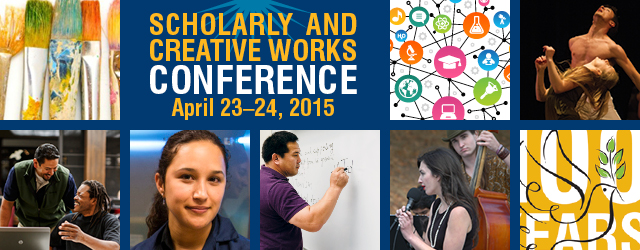
Oral Presentations - Guzman 201
Teaching English Language Learners Common Core Writing Strategies Using the Thesis-Evidence Model in the High School Social Studies Classroom
Location
Guzman 201
Start Date
4-23-2015 7:40 PM
End Date
4-23-2015 7:55 PM
Student Type
Graduate
Faculty Mentor(s)
Madalienne F. Peters, Ed.D.
Presentation Format
Oral Presentation
Abstract/Description
In the 21st century, our public education system is largely failing its growing population of English Language Leaners. EL students are struggling to develop literacy skills in social studies classes at the high school level. This study is designed to investigate and implement teaching strategies that are effective in helping EL students develop literacy skills in social studies in conjunction with the transition to Common Core Standards for high shool writing.
The struggles of EL students in United State’s classrooms has been observed by scholars for over a half century. Strang (1963) points out, “for many of them, ineptitude in speaking, reading, and writing English is a serious educational, vocational, emotional, and social handicap” (p. 14). Nearly fifty years later, educational leaders and scholars alike are still grappling with the same issue. “The pervasive educational under-achievement of children of immigrant families continues to be a matter of serious concern, both for those families and the nation at large” (Haneda and Wells, 2012, p. 297). However, little research addressed how high school social studies teachers can best help their EL students develop literacy skills rooted in the Common Core Writing Standards. Therefore, addressing this issue is not only pragmatic and timely within the field of educational research, but also vital for the success of our EL students.
Being that working with EL students includes many aspects of cultural, linguistic and communicative skills, this teacher action research project is framed within the context of Multiliteracies Theory. Multiliteracies Theory (Cazden, Cope, Cook, Fairclough, Gee Kalantiz, Kress, Luke, Michales, & Nakata, 1996) states as its purpose to help make classroom teachers incorporate various aspects of cultural, linguistic, communicative and technological diversity into their teaching practices for the purpose of helping students become better prepared for a successful life in the global economy. (Cazden, et all, 1996)
References:
Cazden, Cope, Cook, Fairclough, Gee, et all. (1996). A pedagogy of multiliteracies: Designing social futures. Harvard Educational Review, 66(1), 60-93.
Haneda, M., & Wells, G. (2012). Some key pedagogic principles for helping ELLs to succeed in school Taylor & Francis Ltd. doi:10.1080/00405841.2012.726059
Strang, R. (1963). The linguistically handicapped: Learning english as a second Language—A theoretical model. Exceptional Children, 30(1), 14-16. Retrieved from http://ezproxy.dominican.edu/login?
Teaching English Language Learners Common Core Writing Strategies Using the Thesis-Evidence Model in the High School Social Studies Classroom
Guzman 201
In the 21st century, our public education system is largely failing its growing population of English Language Leaners. EL students are struggling to develop literacy skills in social studies classes at the high school level. This study is designed to investigate and implement teaching strategies that are effective in helping EL students develop literacy skills in social studies in conjunction with the transition to Common Core Standards for high shool writing.
The struggles of EL students in United State’s classrooms has been observed by scholars for over a half century. Strang (1963) points out, “for many of them, ineptitude in speaking, reading, and writing English is a serious educational, vocational, emotional, and social handicap” (p. 14). Nearly fifty years later, educational leaders and scholars alike are still grappling with the same issue. “The pervasive educational under-achievement of children of immigrant families continues to be a matter of serious concern, both for those families and the nation at large” (Haneda and Wells, 2012, p. 297). However, little research addressed how high school social studies teachers can best help their EL students develop literacy skills rooted in the Common Core Writing Standards. Therefore, addressing this issue is not only pragmatic and timely within the field of educational research, but also vital for the success of our EL students.
Being that working with EL students includes many aspects of cultural, linguistic and communicative skills, this teacher action research project is framed within the context of Multiliteracies Theory. Multiliteracies Theory (Cazden, Cope, Cook, Fairclough, Gee Kalantiz, Kress, Luke, Michales, & Nakata, 1996) states as its purpose to help make classroom teachers incorporate various aspects of cultural, linguistic, communicative and technological diversity into their teaching practices for the purpose of helping students become better prepared for a successful life in the global economy. (Cazden, et all, 1996)
References:
Cazden, Cope, Cook, Fairclough, Gee, et all. (1996). A pedagogy of multiliteracies: Designing social futures. Harvard Educational Review, 66(1), 60-93.
Haneda, M., & Wells, G. (2012). Some key pedagogic principles for helping ELLs to succeed in school Taylor & Francis Ltd. doi:10.1080/00405841.2012.726059
Strang, R. (1963). The linguistically handicapped: Learning english as a second Language—A theoretical model. Exceptional Children, 30(1), 14-16. Retrieved from http://ezproxy.dominican.edu/login?

